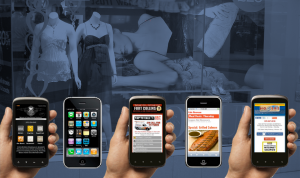 Mobile device adoption is growing exponentially and if you look at almost any industry metric the trajectory for mobile growth over the next five years is stratospheric.
Mobile device adoption is growing exponentially and if you look at almost any industry metric the trajectory for mobile growth over the next five years is stratospheric.
In fact, it’s so ubiquitous it’s hard to image a time when there wasn’t a cacophony of cheesy ringtones chirping happily away in the pockets and handbags of its owners signalling another email, text message or in-coming call.
Along with the growth of the mobile platform has been a lot of hot air and nonsense about mobile marketing or what it’s now more frequently referred to as m-marketing.
Myth #1: To do mobile marketing you need an app
This is the biggest myth and a few years’ ago a bunch of developers would have promised you the earth for a small fortune and talked about having a piece of the world’s most valuable ‘real estate’. Blah blah blah..
Well, unless your mobile app does something spectacular that no other app does – and the chances are it won’t – then don’t splash your cash. Take a leaf out of BlackBerry’s book when its developers revealed that 99 percent of apps only get used once – yes, really, just once!
Myth #2: Mobile marketing is a niche channel for reaching young customer segments
Unbelievably, there are marketers that are in self-denial and don’t see m-marketing as mainstream, but such resistance is futile and the absence of m-marketing should raise some red flags if you’re one of the few to have yet to get on board. As one commentator put it “mobile is the juggernaut that we’re all trying very hard to pretend we don’t see.”
The web is now accessed by mobile devices rather than PCs and every handset, no matter how sophisticated, comes with built-in capability to send and receive text and email messages.
The fact that every mobile has an identifiable customer at the end of it and is totally measurable makes it a powerful channel for two-way communication. There is now more text and picture data traffic than voice data on mobile networks for work, rest and play.
Myth #3: Mobile marketing is just about selling stuff
From a direct marketing perspective, it’s definitely where the action is. But to think of mobile as simply a sales channel is to undermine the significance of m-marketing in the mix. For example, many small-medium sized businesses, such as my hairdresser and the dentist use text messaging to remind me of my next appointment and evidence shows that this simple form of communication has helped save millions in lost revenues as a result of missed appointments.
Other popular uses of m-marketing include keeping customers updated about special offers and discounts on products by rewarding them for being part of the on-line community.
Myth #4: Mobile marketing is just for brand owners with deep pockets
You certainly don’t need a big budget to use m-marketing. One of the delights of mobile marketing is that you can get the ball rolling on a ludicrously small budget; you shouldn’t encounter set up fees, contract terms, or minimum credit orders as there are many suppliers on the market that offer an off-the-shelf product for any type of business which won’t break the bank and run up eye-watering bills with designers, publishers or printers.
Big brands have invested heavily in m-marketing but costs per thousand (CPT) has come down so that smaller companies can also enjoy the return that m-marketing has delivered for much bigger brands at a fraction of the cost of a Google ad.
Myth #5: Mobile marketing is too difficult for legal reasons.
National laws differ between countries but generally speaking if a customer has consented to receiving information on products and services on an opt-in basis and provided this consent has been obtained within existing laws and regulations, there shouldn’t be anything to worry about. For further guidance, see Essential Law for Marketers.
Checklist for ensuring your m-marketing campaign is successful:
- segment you desired customers and prospects with care;
- pay attention to timing and frequency issues;
- test m-marketing campaigns prior to roll-out;
- keep communication personal, relevant and consider using rich media where appropriate to capture interest;
- keep up-to-date with changes in data protection and privacy laws within the relevant territories of the m-marketing campaign; and
- seek guidance on m-marketing best practice from professional bodies such as the Mobile Marketing Association.
For further guidance on m-marketing, refer to High Impact Marketing That Gets Results.














Recent Comments